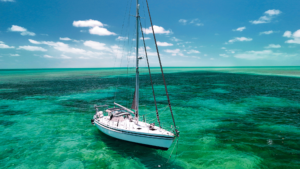When buying a yacht for £100,000 to £250,000 you might not buy you a large boat new, but you can make your money go a long way with the same amount on the used yacht market
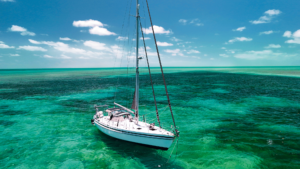
Visit any of the major boat shows with a view to placing an order and a budget of around £100,000 to £250,000 will put you in the production-built yacht market, perhaps up to around 40ft at a stretch. It won’t buy you even the smallest Hallberg-Rassy new. But take the same amount into the used market and a lot of options open up if you’re prepared to buy an older yacht.
Buying a yacht for £100,000-£250,000: A tricky price point?
Buying a yacht is not without complications. It can be hard to predict what will need to be spent, even after having a survey done. Balancing purchase budget and a fund for works that are needed is very important.
“The big advantage of buying an older yacht is that you are trading depreciation, which is an upfront cost, for the cost of refit/upgrade, which is a cost that you can manage and decide when and how to spend,” explains broker Alex Grabau.
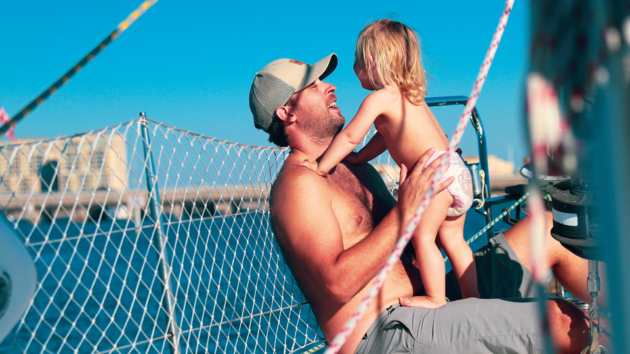
Adapting a pre-loved boat for family cruising can get you more for your money. Photo: Monday Never
“As depreciation is often no longer a notable factor with older boats, an owner must also then understand and accept that such costs of refit/upgrade may then become their ‘cost of ownership’ – with not all of it recoverable upon subsequent resale.”
When it comes to saving money, Grabau says it’s clear what almost everyone looks for first.
“The one everyone wants to buy will be the older boat (so little or no depreciation) where an owner has just refitted or upgraded her for a planned adventure which has either been completed quickly (with little wear or degradation to the equipment), or where the plans have been cancelled.
“The owner will almost certainly see a percentage of their refit investment written off, making the boat a fantastic opportunity for a buyer looking to save some money and, perhaps most importantly, time,” he adds.
Get covered
Once purchased, next steps are likely to mean rectifying any serious faults or problems highlighted by the survey. “The only aspects which are going to stop you heading off immediately relate to safety, reliability and, linked to that, the stipulations of your insurer,” adds Grabau.
“This will usually mean inspection – or in some cases replacement – of standing rigging if older than 10 years, replacement of saildrive diaphragms (if fitted) if over seven years old, thorough servicing of mechanical systems, and either servicing, replacement or upgrade of safety equipment.
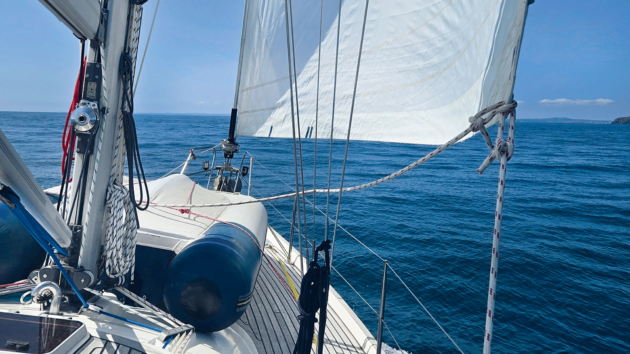
The first post-refit cruise will always be special. Photo: Living With The Tide
“Most other refit items can be attended to immediately, or pushed further down the road if budgets don’t immediately allow.”
Marine insurance companies regularly deal with customers about to buy a yacht that they have plans to improve. Understanding whether the yacht is fundamentally safe is the primary concern of an insurance broker, explains Andy Crick, a director at Pantaenius UK.
“When a customer gets in touch about a yacht they want to insure we take a holistic approach; every yacht really is different. As a broker it is important to consider the fundamentals. Is it likely to catch fire? Is it likely to sink? Is the rig likely to come down?
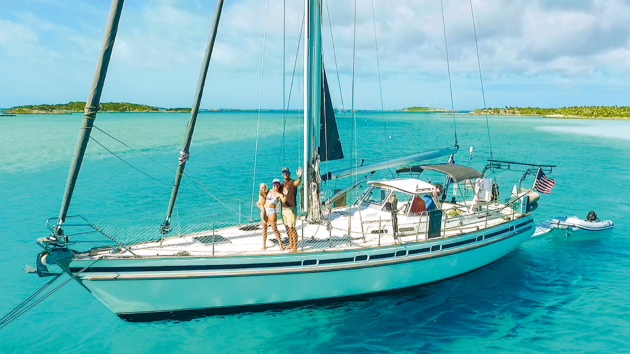
Rescuing another family mid-Atlantic made safety a priority for Will and Cat when seeking their next yacht. Photo: Monday Never
“We regularly insure yachts that have a passage to make to where they are going to have work done, but we need to ensure the yacht is safe for that delivery passage.
“One prospective yacht may need very little work done, having benefitted from a proactive and comprehensive maintenance schedule in prior ownership. Whereas a similar yacht out of the same yard at the time of build may have had a harder life, been cared for less sympathetically over the years and might require extensive work in a number of areas,” says Crick.
What to look for: key considerations by yacht insurance brokers when buying a pre-owned yacht:
■ Type and age of yacht and material of construction
■ Structural integrity of the hull. Has the vessel suffered damage? Have any past repairs been completed properly?
■ Condition of the hull-to-keel joint and age and condition of keel bolts (where relevant)
■ Seacocks and through-hull fittings. What type are they? How old are they? What is their condition? Are all below-the-waterline hoses secure and double clipped?
■ What are the bilge pumping arrangements?
■ Age and condition of stern seals or sail drive seals
■ Rig; type, age, condition, last service, inspection or replacement?
■ Onboard electronics: type and condition of the batteries, condition of the wiring, RCD protection?
■ Onboard gas system (if any), including hoses, pipes, regulator and safe storage of gas bottles. When was the gas system last professionally inspected and serviced?
■ Fire prevention measures and onboard firefighting equipment
■ Condition of the rudder and steering system
■ Main engine and gearbox condition and maintenance
■ Operation of navigation equipment
■ Lifesaving apparatus.
Article continues below…
Taking ownership: Buying a yacht abroad
Buying a yacht abroad is a scenario few cruisers might dare to pursue. Quite apart from the giant leap of…
Second hand boats: buying a classic yacht
Over the last three decades there has been a spectacular classic boat revival, resulting in – and further encouraged by…
We did it
Catherine and Will Marks bought their 1995 Contest 46 Paradox. When it came to finding their second yacht, Will and Catherine Marks had experienced enough sailing to shape a list of features that quickly struggled to tally up with their budget.
Having previously owned a production-built boat, they were determined to buy a yacht that was well built and set up for long term cruising. A little more knowledge, however, had given them a long list of criteria.
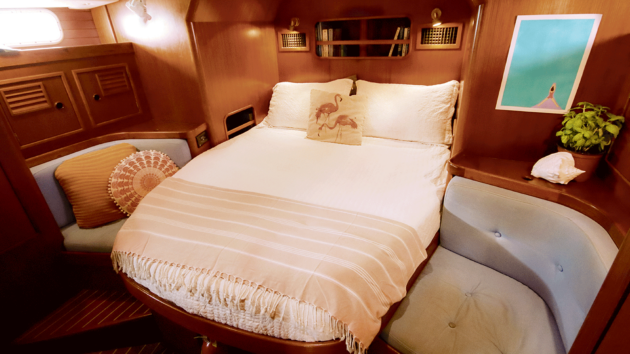
Generous aft cabin makes the Contest 46 very comfortable for living aboard. Photo: Monday Never
“We backed ourselves into a corner with the list we’d come up with.”
An incident while crewing on a Discovery 67 crossing the Atlantic had made a deep impression on the couple a few years before. The video they made of it rescuing a family on a yacht that had lost its rudder now has two million views on YouTube (Monday Never).
“It was an experience we reflected on a lot and certainly had a massive influence on our own decisions afterwards,” explains Will. The couple now have a young child of their own and have been afloat as a family for three years.
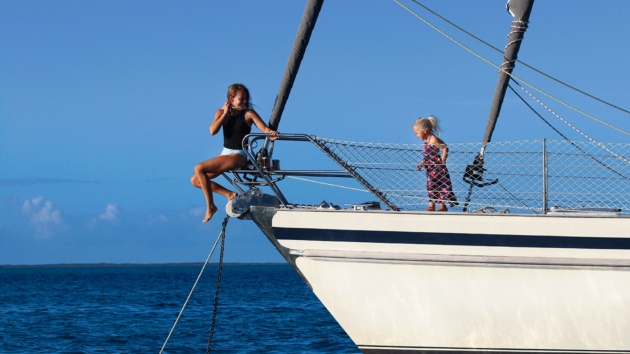
Paradox proved a great family yacht. Photo: Monday Never
“We looked at a lot of boats that met, or were very close to meeting, all of our criteria. Passports, Hylas, Kelly Petersons – I think we looked at over 20 yachts. Eventually we found the Contest – not a particularly well-known yacht in the US, but a boat with a pedigree.
“Finding a quality boat in our price range meant we were often in a bracket where the yacht hadn’t been well looked after, we realised that,” explains Will.
“Our surveyor was great, but he gave us over 110 points to attend to. A handful were urgent. When lockdown hit, we went into the deep end working on the boat. It was then that things emerged the survey couldn’t be expected to pick up, like leaks from deck hatches.”
The couple embarked on a program of works to get the boat how they wanted her. “All in all we invested around $100,000, which we knew we wouldn’t get back, but it put the boat in the right place for what we wanted to do.”
When it came to moving back ashore and selling the yacht earlier this month, Will and Catherine found themselves inundated with offers. “Brokers were quite negative when we made initial enquiries about listing, but we had loads of interest straight away.”
Matt Donald and Paige Grogan have a Contest 40S
Matt and Paige first owned a Contest 40, before trying classic yacht ownership, then deciding to come back to GRP. While they looked at other brands, in the end, they came back to one they were familiar with, choosing a slightly different variant of the Contest 40 they’d owned before.

Matt and Paige livea board with their dog Lancer. Photo: Living With The Tide
“We offered well under the asking price knowing she needed work. We then spent a month and a half in Mayflower Marina, Plymouth, renewing the electrics, heating, refrigeration and rigging. The survey was a good guide to what we really needed to do,” explains Matt.
“This Contest actually has slightly less stowage due to how the water tank is fitted, but we think she has a slightly faster turn of speed. We owned an overland truck for a while as well and had sailed our previous Contest to the Caribbean and back.
“By the time we bought her we’d really figured out what we needed in terms of living comfortably afloat. Paige is a freelance graphic designer, so getting the electrics set up to run laptops all day was important.
“The combination of what she offers in terms of space, being good to sail and her build quality is really what made us buy another Contest,” explains Matt.
 If you enjoyed this….
If you enjoyed this….
Yachting World is the world’s leading magazine for bluewater cruisers and offshore sailors. Every month we have inspirational adventures and practical features to help you realise your sailing dreams.Build your knowledge with a subscription delivered to your door. See our latest offers and save at least 30% off the cover price.
Note: We may earn a commission when you buy through links on our site, at no extra cost to you. This doesn’t affect our editorial independence.
The post Buying a yacht for £100,000-£250,000: Tips and tricks appeared first on Yachting World.
